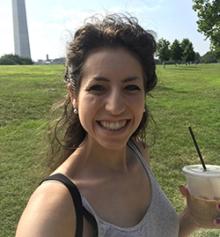In honor of Postdoc Appreciation Week, we highlight Stephanie Sarbanes, Ph.D., postdoctoral fellow in the laboratory of Antonina Roll-Mecak, Ph.D., NINDS Cell Biology and Biophysics section.

Dr. Sarbanes joined the Roll-Mecak lab in October 2020—the heart of the first year of the pandemic. During her initial three months, stuck at home, she devoted her time to reading all about microtubules, the focus of the lab. Dr. Sarbanes soon became intrigued by a unique process called tubulin autoregulation, a feedback mechanism that cells use to sense and control microtubule subunit pools by seeking out the subunit-translating ribosomes and destroying the associated mRNA transcript. Her proposal, titled “Investigation of the tubulin autoregulatory response at the mechanistic level and in the human neuron,” won her a recent NINDS Competitive Fellowship Award (NCFA).
In addition to the NCFA, Dr. Sarbanes is the recipient of an NIGMS Postdoctoral Research Associate Training (PRAT) fellowship and a valued member of the NIH Philharmonia. With her wealth of experiences at the NIH so far, we asked Dr. Sarbanes to answer a few questions about her NINDS research journey.
Why did you choose NIH for your postdoctoral fellowship?
I grew up nearby in Towson, Maryland, and had always hoped to come back to the area to be closer to family. NIH is often spoken about as a scientific utopia, and while I was in grad school, I had two roommates who had wonderful experiences as postbacs here. I had also heard great things about the NIH Office of Intramural Training and Education (OITE) and their incredible support and guidance for postdocs in all sorts of career paths.
One of the things I enjoy about my project is that it reflects the collaborative nature of NINDS and NIH more broadly. I am co-mentored by Dr. Robert Hogg at NHLBI, an expert in RNA decay pathways, and by Dr. Michael Ward at NINDS, exploring tubulin autoregulation in his unique iPSC-derived neuron model. I also constantly rely upon the expertise and camaraderie of fellow postdocs in my building and across several labs.
What made you interested in the tubulin autoregulation pathway?
My thesis work centered around virus entry, and I became interested in microtubules because viruses hijack them to navigate the intracellular world. I was curious how viruses might manipulate or take advantage of the cytoskeleton for their own ends. When I came across the Roll-Mecak Lab at NINDS, I was hooked by this idea of the “tubulin code” and the fact that microtubules are not an inert scaffold but can be diversified in interesting ways with important biological consequences.
Even though the tubulin autoregulation pathway was described in the late 1970s, most of the players are still unknown! Interestingly, the one player that has been identified has disease-associated mutations that result in intellectual disability. I am studying the function of this pathway and protein in neurons where proper construction and regulation of the microtubule cytoskeleton is crucial. Dr. Roll-Mecak has been incredibly supportive throughout my transition into her lab and in discussing and developing these ideas.
What has been your most memorable experience at NINDS so far?
One of my favorite memories at NINDS is my time spent in the tissue culture room with colleagues who have become close friends. We call this time “BTBTC” (back-to-back tissue culture). The cell culture hoods are directly opposed to each other, so we do our cell work while chatting and joking around or listening to someone’s favorite playlist of the day! Also, I’m super thankful for the Call Your Mother trolley across the street for COVID-safe lunch outings with lab mates.
As for the science itself, my work lends itself to a lot of microscopy, and imaging microtubules and cells can be mesmerizing. The dynamics of microtubules can be followed in real time by adding a fluorescent tag to one of the proteins that binds the growing microtubule tips, so you end up with movies that look like shooting fireworks! Also, I had never worked with iPSCs before, and it is beautiful to watch them transform into neurons over the course of a week.
As a busy postdoctoral fellow and member of the NIH Philharmonia, how do you achieve this work-life balance?
I joined the NIH Philharmonia cello section last October playing Beethoven’s 8th symphony— an energetic piece and wonderful return to music-making post-vaccine. It has also been a nice way to meet other trainees at NIH with whom I would never cross paths otherwise. It is very motivating getting through experiments when I know I have orchestra at the end of the day. And when you are playing in the orchestra, you must be completely in the present, so you can’t dwell on failed experiments. Overall, there are important synergies between orchestra and lab—the communal experience of working alongside others towards a common goal while continuously honing your own craft.
What advice have you received that has really made a positive difference in your research or your career?
When I first moved to New York City for my undergraduate education, my mom gave me the advice to “always look up.” She was referring to the often-beautiful architecture at the top of a very utilitarian-looking building that you would miss if you don’t pay attention. I think the advice is applicable to science as well—it is important to map out a path but also to keep your eye out for interesting little details, unexpected results, or intersections with the work of those around you that could yield exciting new insights or directions. Taking a more motivational interpretation, the phrase can also serve as a reminder to keep up your optimism amid those inevitable setbacks.
Contributed by Shana R. Spindler, PhD
